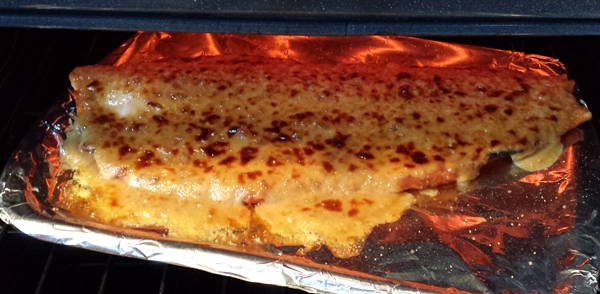Recipe and photos by Gary Yamaguchi For The North American Post
*A legend in his own mind…

I grew up catching and eating salmon in the Pacific Northwest. My grandmother used to make miso salmon, soaking the pieces of fish for three days before cooking and eating it. For my own family, living in Arizona when the recipe was developed, I wanted to try to duplicate the same miso-yaki flavor but without having to wait so long. This was the result — enjoy!
P.S. Our Pacific salmon need your help! The latest threat is very serious and has reduced the salmon and steelhead stocks to only about 2-3% of their population. They face the very real possibility of extinction in our lifetime. Please do your part by watching “Artifishal,” a documentary by Yvon Chouinard and Patagonia. And then avoid purchasing farmed Atlantic salmon! Although it is oily and delicious, I can no longer purchase it in good conscience.
info
• Gary Yamaguchi, ”EARTH DAY FILM,A Sad Fish Story,” napost.com, May 2022.
• wildfishconservancy.org


 Ingredients
Ingredients
●1 large or 2 small fillets of wild-caught salmon, with or without skin attached. The best choices, in order, are Copper River sockeye, sockeye, king, silver (coho) and pink. Avoid chum. The fresher the better. Avoid frozen, if possible.
●1/2 cup mayonnaise
●1/3 cup granulated sugar
●1/4 cup aji-miso (with soup base flavoring added; photo above). If you can’t find it, use regular Shiro-miso and add 2 tsp. Ninben brand Tsuyu-No-Moto seasoning soy sauce.
Pepper
●Heavy-duty aluminum foil


Step 1. Cover a large broiling pan with aluminum foil. Then cut a smaller piece of foil that is the same length and at least 1 inch wider than the fillet of salmon and lay it on top of the broiling pan. Lay the salmon skin side up on top of the smaller piece of foil. The thicker dorsal-fin side of the fillet should be even with one long edge of the foil. The thinner belly (toro) side of the fillet should have an exposed edge of foil that you can grab easily. If the fillet is long, you might have to go diagonally and maybe overhang it just a bit.
Step 2. Place the oven rack in the top position, if the fillet is thin; move rack to the second position, if the fillet is thick. Pepper the fish (so it smells better when broiling) and broil it on high, skin side up until it browns. With richer salmon species, there is more oil so the flesh will turn brown and slightly crispy.
Step 3. While the fillet is broiling, measure out the other ingredients. Put the mayonnaise, sugar and miso into a mixing bowl and stir together thoroughly.
Step 4. Next, you’re going to flip the fish (photo series below). Pepper the uncooked side and broil it until fully cooked. Leave the broiler on.
Step 5. Pour out the miso mixture on top of the cooked fish. Quickly spread it over the fish and then replace fish under the broiler. Watch it closely because it will start bubbling immediately and can burn quickly. Take it out when it has mottled brown spots. If one side has fewer brown spots, you can just take it partway out and let the lighter side brown a bit longer.
For a very thick fillet, turn off the oven, lower the rack and let the fish sit in the hot oven another 10 minutes. The fish should flake easily with a fork when done.
Place fillet on a serving dish, garnish and enjoy! It is best served with a large serving fork and hot Japanese rice.



• When the dorsal side has passed the middle of the pan, raise your side of the foil quickly up and away from you to roll the filet over.
• Remove the extra piece of foil and discard.
Gary Yamaguchi, Lynnwood, WA, previously contributed “Matsutake Fever!” (napost.com, Dec. 2021) and “Say it with PASSION!” (Sept. 2022).
When not in the mountains or on the water, he can be reached at gyflyfish56@gmail.com.







